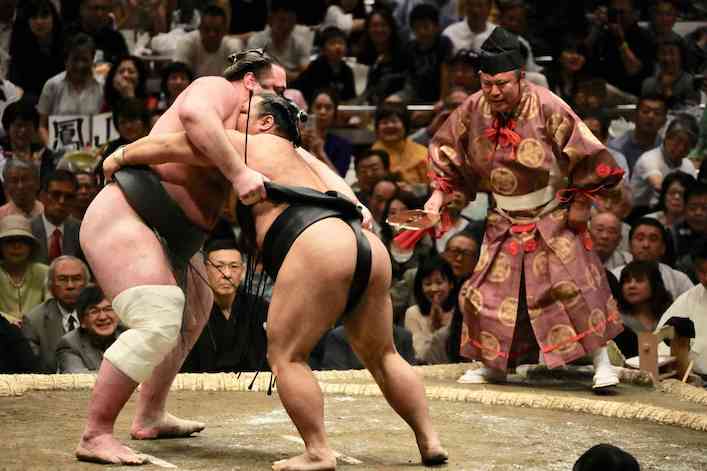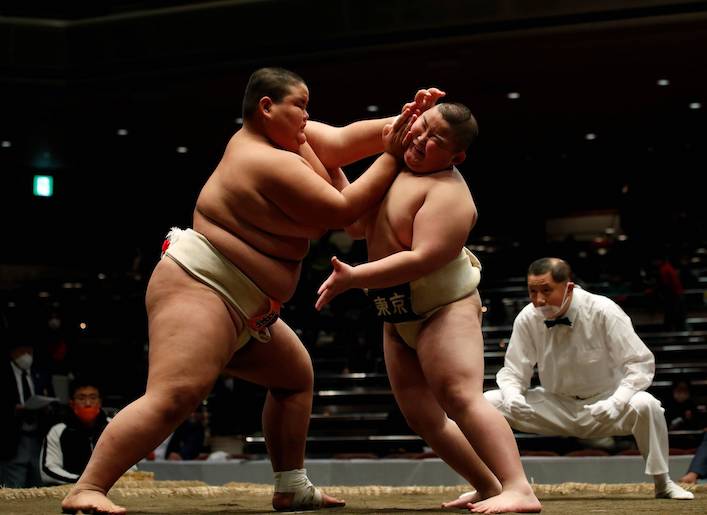
Introduction
Sumo wrestling is a sport that originated in Japan and has gained worldwide recognition for its unique cultural significance and traditions. It is a fascinating and exciting sport that requires immense strength, agility, and skill.
A Brief History of Sumo Wrestling
Sumo wrestling can be traced back to ancient Japan, where it was believed to have been used as a form of spiritual practice. Over time, it evolved into a competitive sport, and the first official sumo tournament was held in Osaka in 1684. Today, sumo wrestling is an integral part of Japanese culture and attracts a global audience.
Importance of Knowing Sumo Wrestling Rules
Understanding the rules of sumo wrestling is essential for anyone who wants to appreciate the sport fully. The rules determine how the wrestlers compete and how the matches are won. By knowing the rules, spectators can appreciate the strategy, technique, and strength of the wrestlers and understand why each match unfolds the way it does.
Without knowledge of the rules, it can be challenging to understand the nuances of the sport and the significance of different moves. Moreover, by knowing the rules, you can also participate in friendly matches and competitions with your friends and family, which is a fun and engaging activity.
In short, sumo wrestling is a fascinating sport with a rich history and unique traditions. Understanding the rules of sumo wrestling is crucial for anyone who wants to appreciate the sport fully. Whether you want to watch matches or participate in friendly matches with friends, knowing the rules will help you enjoy this exciting sport.
Read: Sumo Wrestling’s Impact on Japanese Culture
Basic Rules of Sumo Wrestling
Sumo wrestling is a Japanese contact sport that has gained popularity worldwide. The rules of Sumo wrestling are very simple. Here is a detailed explanation of the basic rules of Sumo wrestling:
A. Objective of the game
- The objective of Sumo wrestling is to force the opponent out of the ring or to make any part of their body other than the soles of their feet touch the ground.
B. Match duration
- A Sumo wrestling match lasts for a maximum of 4 minutes.
- If neither wrestler has won after the specified time, the match is declared a draw.
C. Fighting area
- The fighting area is a circular ring called a dohyo, which is 4.55 meters in diameter and is made of clay and covered with sand.
- The dohyo is surrounded by a tawara, a bale of straw rope, to mark the boundaries of the ring.
D. Starting positions
- The starting position for each wrestler is in their assigned corner of the dohyo called the shikiri-sen.
- The wrestlers face each other and crouch down with their fists on the ground, called shikiri, before the match starts.
E. Winning techniques
- There are several techniques that a wrestler can use to win a Sumo wrestling match.
- The most common techniques are:
- Oshidashi: pushing the opponent out of the ring
- Yorikiri: forcing the opponent out of the ring by grabbing their mawashi, or belt
- Hatakikomi: a pulling technique that causes the opponent to fall down
- Uwatenage: a throwing technique that lifts the opponent and throws them out of the ring
- Oshidashi: pushing the opponent out of the ring
In fact, Sumo wrestling may seem like a simple sport, but it requires a lot of practice, training, and technique from the wrestlers to become successful. The rules of Sumo wrestling are straightforward, making it easy for spectators to understand and enjoy the sport.
Read: Best Strategies to Negotiate Your Pay as a Footballer
Equipment and Dress Code
Sumo wrestling has a unique dress code that is essential to ensure a fair and safe competition. Let’s take a closer look at the equipment and clothing items that sumo wrestlers wear during matches:
A. Mawashi – The Loincloth
Perhaps the most recognizable piece of sumo wrestling gear is the mawashi, which is a long, thick loincloth that is wrapped several times around the waist and secured with a knot. The mawashi is made of thick cotton and is designed to protect the wrestlers from injuries during matches. It also serves to provide a good grip for the wrestlers to hold onto while trying to throw their opponents out of the ring.
B. Other Clothing Items
Aside from the mawashi, sumo wrestlers typically wear a simple t-shirt or vest and a pair of thin cotton shorts underneath. They also wear white bandages around their lower legs, called tate-sen, which provide support and protection.
C. Importance of Proper Dress Code
Proper dress code is crucial in sumo wrestling, as it not only helps prevent injuries but also ensures a fair match. The mawashi worn by each wrestler must be made of a certain type and thickness of cotton and must be inspected before each match to ensure it meets the standards. Any wrestler found to be wearing a non-regulation mawashi is disqualified from the match.
Aside from the official regulations, many sumo wrestlers also believe that the mawashi serves as a symbol of the sport’s traditions and honor. They believe that wearing it properly and with respect shows their dedication and commitment to the sport and its history.
In summary, the equipment and dress code in sumo wrestling are straightforward but critically important. The mawashi and other clothing items worn by wrestlers serve to protect them from injuries and ensure a fair match, while also symbolizing the sport’s rich history and traditions.
Innovative Tech Solutions, Tailored for You
Our leading tech firm crafts custom software, web & mobile apps, designed with your unique needs in mind. Elevate your business with cutting-edge solutions no one else can offer.
Start Now
Pre-match Rituals
A. Ring-entering ceremony
Sumo wrestlers enter the ring wearing a special apron, which is removed after they enter. They then perform the ring-entering ceremony or dohyō-iri, which involves a series of stylized movements. The purpose of this ceremony is to show respect for the ring, the gods, and the spectators.
B. Shiko – sumo wrestler’s workout
After the ring-entering ceremony, the wrestlers perform the shiko, a type of leg-stretching exercise. This exercise is an essential part of sumo training and is believed to help build leg strength and improve balance.
C. Chalk tossing
Following the shiko, each wrestler tosses a handful of salt into the ring. This serves to purify the ring and is done to ward off evil spirits. The wrestlers then take their positions in the ring.
D. Paying respects to the gods
Before the match begins, the wrestlers raise their hands in prayer to the gods. This is to show respect and to ask for protection during the match. After this, the wrestlers return to their starting positions and await the start of the match.
Pre-match rituals are an important part of sumo wrestling and are performed with great reverence. They not only show respect for the ring and the gods but also help the wrestlers to focus their minds and prepare for the match ahead. Each ritual has a specific purpose, and together they create a unique and powerful atmosphere that sets sumo wrestling apart from other sports.
Fouls and Disqualifications
Sumo wrestling, a sport rooted in centuries-old tradition, boasts of a unique set of rules that govern its matches. Players have to follow these regulations strictly, as violations can lead to fouls or disqualifications. Let’s take a closer look at the different types of fouls, penalties, and disqualifications in sumo wrestling.
A. Types of fouls
Fouls are violations of the sumo wrestling rules that can result in a player losing the match or being disqualified altogether.
Here are some of the most common types of fouls in sumo wrestling:
- Touching the ground with any body part aside from the soles of the feet: In sumo wrestling, players are not allowed to touch the ground with any other part of their body besides the soles of their feet. If a wrestler’s knee or hand touches the ground, this constitutes a foul, and they lose the match.
- Crossing the boundary lines: The sumo ring, or dohyo, is a circular platform with a diameter of around 15 feet. Players must stay within the ring at all times during a match. Stepping outside of the ring results in a loss for the wrestler who does so.
- Grabbing the opponent’s hair, throat, or clothing: Sumo wrestlers are not allowed to grab their opponent’s hair, throat, or any article of clothing during the match. Doing so constitutes a foul, and can lead to a loss or disqualification.
B. Penalties
Penalties are the consequences for committing a foul in sumo wrestling. The severity of the penalty depends on the type of foul committed.
Here are some of the most common penalties in sumo wrestling:
- Fusenpai: If a wrestler does not show up for a match, they are considered to have forfeited the match by default. This is known as fusenpai.
- Hikiwake: A tied match in sumo wrestling can result in a penalty called hikiwake. In this case, both wrestlers are declared equal, and neither wins nor loses.
- Mubobi: If a wrestler engages in an attempt to grab their opponent’s hair, throat, or clothing, but does not succeed, they receive a warning called mubobi.
C. Disqualifications
Violating sumo wrestling rules can lead to the most severe consequence – disqualification, potentially banning a player from future competitions.
Here are some of the most common types of disqualifications in sumo wrestling:
- Kinjite: Kinjite is a type of disqualification that occurs when a sumo wrestler engages in illegal sexual behavior. The sport immediately bans the wrestler from competing for this behavior.
- Fusenpai loss: As mentioned earlier, a wrestler who fails to show up for a match receives a fusenpai loss. This also counts as a disqualification.
- Hansoku: This is a disqualification that occurs when a wrestler receives four warnings (mubobi) during a match. In this case, the opposing wrestler wins the match.
All in all, sumo wrestling is a fascinating sport with a rich history and a unique set of rules. Fouls, penalties, and disqualifications are all important aspects of the sport that players and spectators must be familiar with. By understanding the different types of fouls and their consequences, players can compete fairly and safely in the ring.
Read: How to Find Value in Betting on Underdog Teams

Sumo Wrestling Tournaments
Sumo wrestling is not just a sport, it is a revered tradition in Japan that dates back centuries. It is an art form that requires discipline, respect, and dedication. Japan and other countries with significant Japanese populations hold sumo wrestling tournaments throughout the year. In this chapter, we will discuss some of the basic rules of sumo wrestling and provide an overview of the different types of tournaments, ranking system, and prize money.
A. Types of Tournaments
There are six major tournaments, or basho, held in Japan every year, each lasting 15 days. These tournaments take place in Tokyo, Osaka, Nagoya, and Fukuoka. The tournaments are named after the month in which they occur, such as Haru Basho (Spring Tournament), Natsu Basho (Summer Tournament), Aki Basho (Autumn Tournament), and Kyushu Basho (Winter Tournament). The tournaments are organized by the Japan Sumo Association and are a big part of Japanese culture.
B. Ranking System
The ranking system, or banzuke, is an important aspect of sumo wrestling. The wrestlers are divided into six divisions, each with its own rank, from the lowest to the highest. The divisions are Jonokuchi, Jonidan, Sandanme, Makushita, Juryo, and Makuuchi. A wrestler’s rank is determined by his performance in previous tournaments. The higher the rank, the higher the salary and prestige.
C. Prize Money
Sumo wrestling is a lucrative sport, with top wrestlers earning millions of yen each year. The prize money for each tournament is substantial and increases with the wrestler’s rank. The top-ranked wrestlers in the Makuuchi division can earn up to 10 million yen ($90,000) per tournament. The prize money is shared among the wrestlers in each division, with the winner receiving the lion’s share.
Basically, sumo wrestling is a fascinating sport that requires immense physical and mental strength. The tournaments are an essential part of Japanese culture, attracting huge crowds of locals and tourists alike. The ranking system and prize money add an extra layer of excitement to the tournaments and provide an incentive for wrestlers to perform their best. Despite the popularity of other sports in Japan and around the world, sumo wrestling continues to be a revered tradition that inspires reverence and admiration.
Read: How do Football Clubs Make Money?
Conclusion
Sumo wrestling, a traditional Japanese sport, has preserved its centuries-old rules. This physical contact sport ensures fair play and safety with its unique regulations.
In sumo wrestling, the goal is to push your opponent out of the ring or make them touch the ground with any part other than their feet. This objective demands strength, agility, and strategy.
The wrestlers, or rikishi, wear a mawashi, a loincloth made from silk or cotton. Their unique topknot hairstyle is considered a vessel of spiritual power. Both these elements tie the sport to its deep cultural roots.
At the beginning of each match, the wrestlers crouch with hands touching the ground. Only when both fists meet the ground does the battle commence. This starting position echoes the sport’s emphasis on mutual respect and readiness.
Seamless API Connectivity for Next-Level Integration
Unlock limitless possibilities by connecting your systems with a custom API built to perform flawlessly. Stand apart with our solutions that others simply can’t offer.
Get StartedIn the ring, wrestlers deploy a range of grappling techniques. They can push, pull, or throw to overpower their opponent. Actions such as punching, kicking, or hair-pulling, however, are strictly prohibited, promoting a fair and respectful contest.
The ring, or dohyo, bounds the match’s action. Touching the ground outside the dohyo means instant loss. If a wrestler deliberately steps out, they forfeit the match, emphasizing the importance of maintaining the arena’s integrity.
The sport of sumo wrestling provides a fascinating cultural spectacle. Its rules not only ensure safety and fair competition but also preserve its longstanding traditions. Watching a sumo match offers an exciting and enlightening experience, deeply rooted in Japanese culture and the discipline of its athletes.
Before You Go…
Hey, thank you for reading this blog to the end. I hope it was helpful. Let me tell you a little bit about Nicholas Idoko Technologies. We help businesses and companies build an online presence by developing web, mobile, desktop, and blockchain applications.
We also help aspiring software developers and programmers learn the skills they need to have a successful career. Take your first step to becoming a programming boss by joining our Learn To Code academy today!
Be sure to contact us if you need more information or have any questions! We are readily available.










